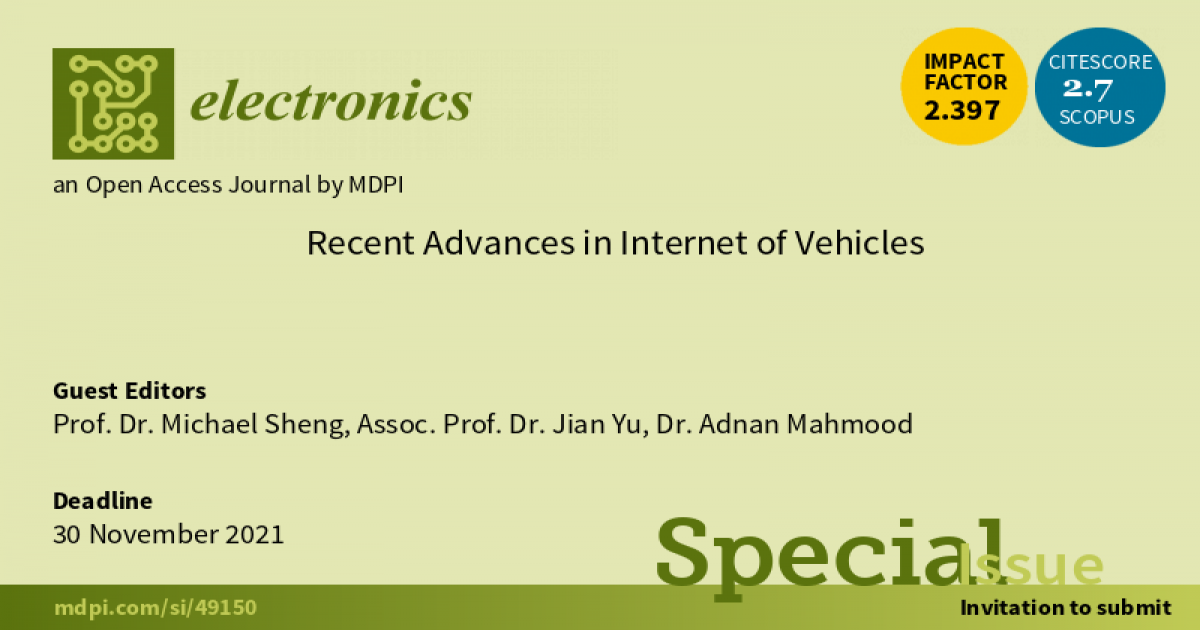Recent Advances in Internet of Vehicles
A special issue of Electronics (ISSN 2079-9292). This special issue belongs to the section "Electrical and Autonomous Vehicles".
Deadline for manuscript submissions: closed (30 November 2021) | Viewed by 14166

Special Issue Editors
Interests: web of things; internet of things; big data analytics; web science; service-oriented computing; pervasive computing; sensor networks
Special Issues, Collections and Topics in MDPI journals
Interests: graph neural networks; recommender systems and deep learning; web and ubiquitous computing; service-oriented computing; complex networks
Special Issues, Collections and Topics in MDPI journals
Interests: internet of things; internet of vehicles; trust management; cloud, fog, and edge computing; software-defined networking; next-generation wireless networks
Special Issues, Collections and Topics in MDPI journals
Special Issue Information
Dear Colleagues,
Recent considerable advancements in the emerging yet promising paradigm of the Internet of Things (IoT) and its convergence with the state-of-the-art wireless communication technologies has led to the evolution of conventional vehicular ad hoc networks (VANETs) into the Internet of Vehicles (IoV). IoV is primarily an amalgamation of a variety of network entities, i.e., vehicles, vulnerable pedestrians, and supporting roadside infrastructure, and acts as a dynamic communication system for facilitating real-time efficient information sharing among these entities in order to guarantee safer navigation and intelligent traffic management. This not only entails vehicle-to-vehicle communication but also takes into consideration vehicle-to-human, vehicle-to-road, and vehicle-to-sensor interactions. Hence, the notion of IoV is presently being explored by researchers and scientists from both academia and industry; nevertheless, significant developments from a wide variety of technological facets still need to be materialized so as to unleash the true potential of IoV in the realm of the intelligent transportation system which itself is integral to the evolution of futuristic smart and connected cities.
This Special Issue, accordingly, welcomes original contributions so as to bring forth the state-of-the-art advancements in the IoV landscape. Both high-quality survey and technical contributions are welcome for this Special Issue.
Topics include but are not limited to:
- Promising architectures and protocols for IoV
- Emerging communication technologies for IoV (DSRC, mmWave, terahertz, etc.)
- Security and privacy issues in IoV
- Machine-learning-based techniques/algorithms for IoV
- Software-defined approaches in IoV
- Blockchain-enabled IoV
- Trust and reputation management in IoV
- Leveraging fog and edge computing in IoV
- Intelligent resource management in IoV
- Quality-of-service and quality-of-experience in IoV
- Social IoV
- Big data analytics in IoV
- Autonomic service delivery in IoV
- Testbed and simulation tools for IoV
Prof. Dr. Michael Sheng
Assoc. Prof. Dr. Jian Yu
Dr. Adnan Mahmood
Guest Editors
Manuscript Submission Information
Manuscripts should be submitted online at www.mdpi.com by registering and logging in to this website. Once you are registered, click here to go to the submission form. Manuscripts can be submitted until the deadline. All submissions that pass pre-check are peer-reviewed. Accepted papers will be published continuously in the journal (as soon as accepted) and will be listed together on the special issue website. Research articles, review articles as well as short communications are invited. For planned papers, a title and short abstract (about 250 words) can be sent to the Editorial Office for assessment.
Submitted manuscripts should not have been published previously, nor be under consideration for publication elsewhere (except conference proceedings papers). All manuscripts are thoroughly refereed through a single-blind peer-review process. A guide for authors and other relevant information for submission of manuscripts is available on the Instructions for Authors page. Electronics is an international peer-reviewed open access semimonthly journal published by MDPI.
Please visit the Instructions for Authors page before submitting a manuscript. The Article Processing Charge (APC) for publication in this open access journal is 2400 CHF (Swiss Francs). Submitted papers should be well formatted and use good English. Authors may use MDPI's English editing service prior to publication or during author revisions.
Keywords
- Internet of Vehicles;
- Heterogeneous wireless networks;
- Software-defined networking;
- Intelligent resource management;
- Big data analytics;
- Security, privacy, and quality-of-service
Benefits of Publishing in a Special Issue
- Ease of navigation: Grouping papers by topic helps scholars navigate broad scope journals more efficiently.
- Greater discoverability: Special Issues support the reach and impact of scientific research. Articles in Special Issues are more discoverable and cited more frequently.
- Expansion of research network: Special Issues facilitate connections among authors, fostering scientific collaborations.
- External promotion: Articles in Special Issues are often promoted through the journal's social media, increasing their visibility.
- Reprint: MDPI Books provides the opportunity to republish successful Special Issues in book format, both online and in print.
Further information on MDPI's Special Issue policies can be found here.







